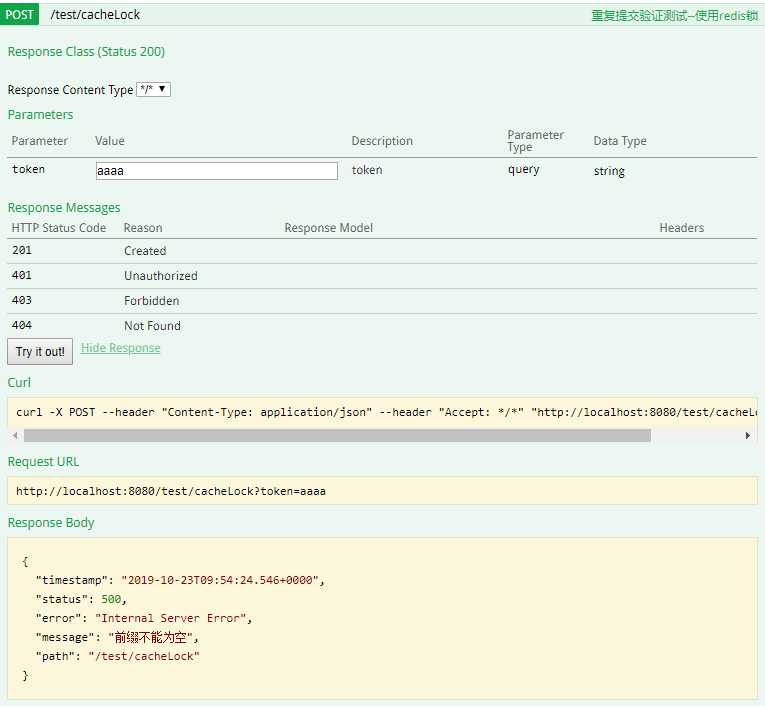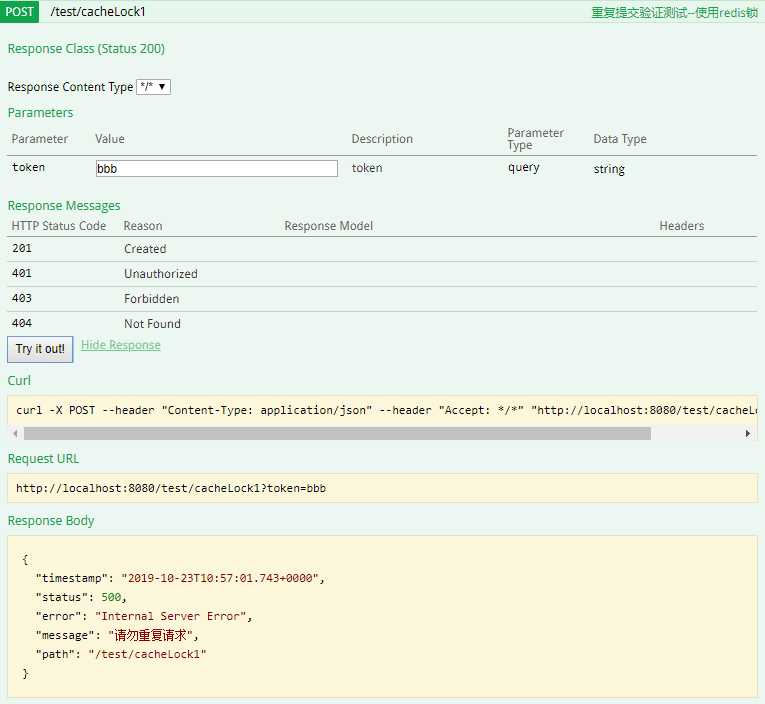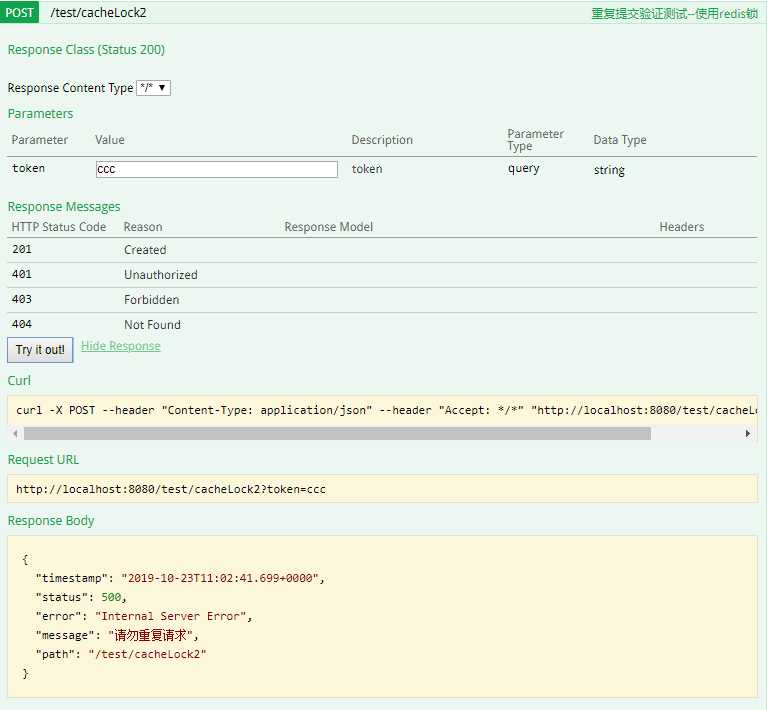标签:proc 方法参数 temp methods 否则 img tac declare redislock
防止重复提交,主要是使用锁的形式来处理,如果是单机部署,可以使用本地缓存锁(Guava)即可,如果是分布式部署,则需要使用分布式锁(可以使用zk分布式锁或者redis分布式锁),本文的分布式锁以redis分布式锁为例。
一、本地锁(Guava)
1、导入依赖
<dependency>
<groupId>org.springframework.boot</groupId>
<artifactId>spring-boot-starter-aop</artifactId>
</dependency>
<dependency>
<groupId>com.google.guava</groupId>
<artifactId>guava</artifactId>
<version>21.0</version>
</dependency>
2、自定义本地锁注解
package com.example.demo.utils; import java.lang.annotation.*; @Target({ElementType.METHOD}) @Retention(RetentionPolicy.RUNTIME) @Documented @Inherited public @interface LocalLock { String key() default ""; //过期时间,使用本地缓存可以忽略,如果使用redis做缓存就需要 int expire() default 5; }
3、本地锁注解实现
package com.example.demo.utils; import com.google.common.cache.Cache; import com.google.common.cache.CacheBuilder; import org.aspectj.lang.ProceedingJoinPoint; import org.aspectj.lang.Signature; import org.aspectj.lang.annotation.Around; import org.aspectj.lang.annotation.Aspect; import org.aspectj.lang.reflect.MethodSignature; import org.springframework.context.annotation.Configuration; import org.springframework.util.StringUtils; import java.lang.reflect.Method; import java.util.concurrent.TimeUnit; @Aspect @Configuration public class LockMethodInterceptor { //定义缓存,设置最大缓存数及过期日期 private static final Cache<String,Object> CACHE = CacheBuilder.newBuilder().maximumSize(1000).expireAfterWrite(20, TimeUnit.SECONDS).build(); @Around("execution(public * *(..)) && @annotation(com.example.demo.utils.LocalLock)") public Object interceptor(ProceedingJoinPoint joinPoint){ MethodSignature signature = (MethodSignature) joinPoint.getSignature(); Method method = signature.getMethod(); LocalLock localLock = method.getAnnotation(LocalLock.class); String key = getKey(localLock.key(),joinPoint.getArgs()); if(!StringUtils.isEmpty(key)){ if(CACHE.getIfPresent(key) != null){ throw new RuntimeException("请勿重复请求!"); } CACHE.put(key,key); } try{ return joinPoint.proceed(); }catch (Throwable throwable){ throw new RuntimeException("服务器异常"); }finally { } } private String getKey(String keyExpress, Object[] args){ for (int i = 0; i < args.length; i++) { keyExpress = keyExpress.replace("arg[" + i + "]", args[i].toString()); } return keyExpress; } }
4、控制层
@ResponseBody @PostMapping(value ="/localLock") @ApiOperation(value="重复提交验证测试--使用本地缓存锁") @ApiImplicitParams( {@ApiImplicitParam(paramType="query", name = "token", value = "token", dataType = "String")}) @LocalLock(key = "localLock:test:arg[0]") public String localLock(String token){ return "sucess====="+token; }
5、测试
第一次请求:

未过期再次访问:

二、Redis分布式锁
1、导入依赖
导入aop依赖和redis依赖即可
2、配置
配置redis连接信息即可
3、自定义分布式锁注解
package com.example.demo.utils; import java.lang.annotation.*; import java.util.concurrent.TimeUnit; @Target(ElementType.METHOD) @Retention(RetentionPolicy.RUNTIME) @Documented @Inherited public @interface CacheLock { //redis锁前缀 String prefix() default ""; //redis锁过期时间 int expire() default 5; //redis锁过期时间单位 TimeUnit timeUnit() default TimeUnit.SECONDS; //redis key分隔符 String delimiter() default ":"; }
4、自定义key规则注解
由于redis的key可能是多层级结构,例如 redistest:demo1:token:kkk这种形式,因此需要自定义key的规则。
package com.example.demo.utils; import java.lang.annotation.*; @Target({ElementType.METHOD,ElementType.PARAMETER,ElementType.FIELD}) @Retention(RetentionPolicy.RUNTIME) @Documented @Inherited public @interface CacheParam { String name() default ""; }
5、定义key生成策略接口
package com.example.demo.service; import org.aspectj.lang.ProceedingJoinPoint; import org.springframework.stereotype.Service; public interface CacheKeyGenerator { //获取AOP参数,生成指定缓存Key String getLockKey(ProceedingJoinPoint joinPoint); }
6、定义key生成策略实现类
package com.example.demo.service.impl; import com.example.demo.service.CacheKeyGenerator; import com.example.demo.utils.CacheLock; import com.example.demo.utils.CacheParam; import org.aspectj.lang.ProceedingJoinPoint; import org.aspectj.lang.reflect.MethodSignature; import org.springframework.util.ReflectionUtils; import org.springframework.util.StringUtils; import java.lang.annotation.Annotation; import java.lang.reflect.Field; import java.lang.reflect.Method; import java.lang.reflect.Parameter; public class CacheKeyGeneratorImp implements CacheKeyGenerator { @Override public String getLockKey(ProceedingJoinPoint joinPoint) { //获取连接点的方法签名对象 MethodSignature methodSignature = (MethodSignature) joinPoint.getSignature(); //Method对象 Method method = methodSignature.getMethod(); //获取Method对象上的注解对象 CacheLock cacheLock = method.getAnnotation(CacheLock.class); //获取方法参数 final Object[] args = joinPoint.getArgs(); //获取Method对象上所有的注解 final Parameter[] parameters = method.getParameters(); StringBuilder sb = new StringBuilder(); for(int i=0;i<parameters.length;i++){ final CacheParam cacheParams = parameters[i].getAnnotation(CacheParam.class); //如果属性不是CacheParam注解,则不处理 if(cacheParams == null){ continue; } //如果属性是CacheParam注解,则拼接 连接符(:)+ CacheParam sb.append(cacheLock.delimiter()).append(args[i]); } //如果方法上没有加CacheParam注解 if(StringUtils.isEmpty(sb.toString())){ //获取方法上的多个注解(为什么是两层数组:因为第二层数组是只有一个元素的数组) final Annotation[][] parameterAnnotations = method.getParameterAnnotations(); //循环注解 for(int i=0;i<parameterAnnotations.length;i++){ final Object object = args[i]; //获取注解类中所有的属性字段 final Field[] fields = object.getClass().getDeclaredFields(); for(Field field : fields){ //判断字段上是否有CacheParam注解 final CacheParam annotation = field.getAnnotation(CacheParam.class); //如果没有,跳过 if(annotation ==null){ continue; } //如果有,设置Accessible为true(为true时可以使用反射访问私有变量,否则不能访问私有变量) field.setAccessible(true); //如果属性是CacheParam注解,则拼接 连接符(:)+ CacheParam sb.append(cacheLock.delimiter()).append(ReflectionUtils.getField(field,object)); } } } //返回指定前缀的key return cacheLock.prefix() + sb.toString(); } }
7、分布式注解实现
package com.example.demo.utils; import com.example.demo.service.CacheKeyGenerator; import org.aspectj.lang.ProceedingJoinPoint; import org.aspectj.lang.annotation.Around; import org.aspectj.lang.annotation.Aspect; import org.aspectj.lang.reflect.MethodSignature; import org.springframework.beans.factory.annotation.Autowired; import org.springframework.context.annotation.Configuration; import org.springframework.data.redis.connection.RedisStringCommands; import org.springframework.data.redis.core.RedisCallback; import org.springframework.data.redis.core.StringRedisTemplate; import org.springframework.data.redis.core.types.Expiration; import org.springframework.util.StringUtils; import java.lang.reflect.Method; @Aspect @Configuration public class CacheLockMethodInterceptor { @Autowired public CacheLockMethodInterceptor(StringRedisTemplate stringRedisTemplate, CacheKeyGenerator cacheKeyGenerator){ this.cacheKeyGenerator = cacheKeyGenerator; this.stringRedisTemplate = stringRedisTemplate; } private final StringRedisTemplate stringRedisTemplate; private final CacheKeyGenerator cacheKeyGenerator; @Around("execution(public * * (..)) && @annotation(com.example.demo.utils.CacheLock)") public Object interceptor(ProceedingJoinPoint joinPoint){ MethodSignature methodSignature = (MethodSignature) joinPoint.getSignature(); Method method = methodSignature.getMethod(); CacheLock cacheLock = method.getAnnotation(CacheLock.class); if(StringUtils.isEmpty(cacheLock.prefix())){ throw new RuntimeException("前缀不能为空"); } //获取自定义key final String lockkey = cacheKeyGenerator.getLockKey(joinPoint); final Boolean success = stringRedisTemplate.execute( (RedisCallback<Boolean>) connection -> connection.set(lockkey.getBytes(), new byte[0], Expiration.from(cacheLock.expire(), cacheLock.timeUnit()) , RedisStringCommands.SetOption.SET_IF_ABSENT)); if (!success) { // TODO 按理来说 我们应该抛出一个自定义的 CacheLockException 异常;这里偷下懒 throw new RuntimeException("请勿重复请求"); } try { return joinPoint.proceed(); } catch (Throwable throwable) { throw new RuntimeException("系统异常"); } } }
8、主函数调整
主函数引入key生成策略
@Bean public CacheKeyGenerator cacheKeyGenerator(){ return new CacheKeyGeneratorImp(); }
9、Controller
@ResponseBody @PostMapping(value ="/cacheLock") @ApiOperation(value="重复提交验证测试--使用redis锁") @ApiImplicitParams( {@ApiImplicitParam(paramType="query", name = "token", value = "token", dataType = "String")}) //@CacheLock @CacheLock() public String cacheLock(String token){ return "sucess====="+token; } @ResponseBody @PostMapping(value ="/cacheLock1") @ApiOperation(value="重复提交验证测试--使用redis锁") @ApiImplicitParams( {@ApiImplicitParam(paramType="query", name = "token", value = "token", dataType = "String")}) //@CacheLock @CacheLock(prefix = "redisLock.test",expire = 20) public String cacheLock1(String token){ return "sucess====="+token; } @ResponseBody @PostMapping(value ="/cacheLock2") @ApiOperation(value="重复提交验证测试--使用redis锁") @ApiImplicitParams( {@ApiImplicitParam(paramType="query", name = "token", value = "token", dataType = "String")}) //@CacheLock @CacheLock(prefix = "redisLock.test",expire = 20) public String cacheLock2(@CacheParam(name = "token") String token){ return "sucess====="+token; }
10、测试
(1)由于cacheLock方法的CacheLock注解没有加prefix前缀,因此会报错

(2)没有加CacheParam注解
第一次调用:

缓存信息:
可以发现key为prifix的值

第二次调用:

(3)增加了CacheParam注解
第一次调用:

缓存信息:
可以发现缓存的内容为prefix+@CacheParam

第二次调用:

SpringBoot--防止重复提交(锁机制---本地锁、分布式锁)
标签:proc 方法参数 temp methods 否则 img tac declare redislock
原文地址:https://www.cnblogs.com/liconglong/p/11728136.html